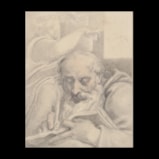RICHARD COSWAY
(1742-1821)A drawing of a half-length seated elderly saint, possibly Matthew the Apostle, visited by an Angel; circa 1810-19
Circa 1810-19
20 x 16 cm (7 ⁷/₈ x 6 ¹/₄ inches) unframed
Pencil with wash, set in the artist’s mount
£2,250
This drawing appears to be unfinished; most attention has been paid to the figure in the foreground; however, those in the background remain faded. This can be said especially for the upper right-hand side of the image, in which there are faint pencil lines, which seem to depict either a landscape or a painting in the background. Though not immediately apparent, it is probable that this is intended to be the crucifixion, as is in the back of the de Gheyn engraving. Matthew was not present at the crucifixion but wrote about it in his gospel, and the scene is depicting this process.
Whilst a large majority of Richard Cosway’s artistic output was through portrait miniatures, he was also a skilled draftsman, as is demonstrated in this work. Cosway’s training had been undertaken at William Shipley’s Drawing School, and it had been through this medium that Cosway had first developed his skill as an artist. Aside from subjects such as the present example, he also commonly drew portraits of sitters, including his wife, numerous versions of these portraits having been sold for large amounts at auction since.
Called ‘The Macaroni Miniature Painter’ by some[2] Cosway and his wife were society high-fliers, and hosted salons and lavish parties in their Pall Mall home. Such a social standing would have been important for his business as a miniature painter, and allowed him to develop the connections and popularity necessary for becoming the miniature painter to the Prince of Wales in 1785. He had an extensive collection of old master paintings, drawings, and prints, and it is possible that he had a version of the de Gheyn engraving within this collection.
[1] For one version see the David Wesleyan Art Centre, accession number 1966.21.1.1.
[2] A title quoted in The Art Amateur, vol. 8, no. 2, January 1883, p. 38.

shipping notice
Worldwide shipping is included in all prices.
The Limner Company does not accept any responsibility for import duty, this is to be paid by the buyer.
Some stock items contain materials from endangered species which are governed by CITES regulations and will require a permit to export outside of Great Britain. If a certificate of export is required then this will be the responsibility of and paid for by the buyer .
you may also like



 +44(0)7983510056
+44(0)7983510056











